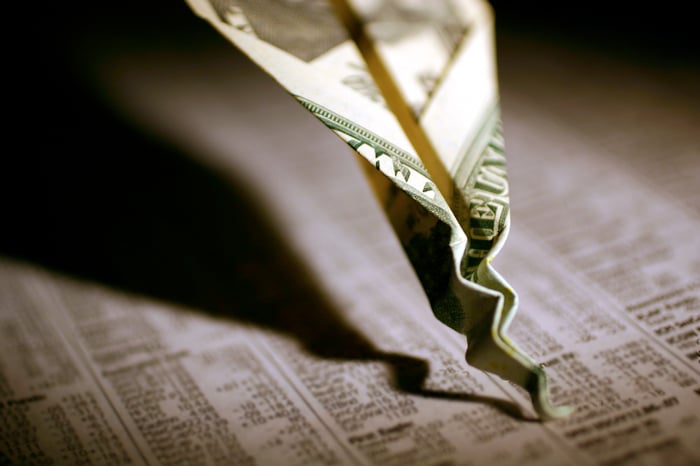For most investors, last year served as a reminder that the stock market doesn't move up in a straight line -- even if 2021 made us believe it did. The start of a new year brings with it new opportunity for the iconic Dow Jones Industrial Average (^DJI -0.11%), broad-based S&P 500 (^GSPC 0.02%), and tech-dependent Nasdaq Composite (^IXIC 0.10%), to break out of their respective bear markets.
However, the optimism we've witnessed in the Dow, S&P 500, and Nasdaq Composite through the first two weeks of the trading year may need to be put on hold based on newly released data from Federal Reserve Bank of New York.

Image source: Getty Images.
This recession-forecasting tool hasn't been wrong in over a half-century
If there's an elephant in the room for Wall Street, it's the dread 'r' word: recession.
While there are a number of macroeconomic indicators that can be used to assess the likelihood of a gross domestic product retracement in the U.S., such as the U.S. unemployment rate and the ISM Manufacturing Index, it's the Treasury bond yield curve that's most often relied on as a harbinger of trouble to come for the U.S. economy.
In a healthy economy, the Treasury yield curve slopes up and to the right. This means longer-dated maturities (10-year and 30-year Treasury bonds) have higher yields than shorter-dated bonds (three-month and two-year Treasury bonds). Since your money will be tied up for a longer period, the expectation is you'll receive a higher yield in return.
But when economic trouble and/or uncertainty are brewing, it's not uncommon for this yield curve to flatten or even invert. A yield curve inversion, like we're experiencing now, involves short-term-maturing bonds sporting higher yields than longer-dated Treasury bonds. It's an indication that investors are worried about the U.S. economic outlook.
For the past 64 years, the Federal Reserve Bank of New York has used the Treasury yield spread between the 10-year bond rate and three-month bond rate to calculate the probability of a U.S. recession occurring within the next 12 months. Over these 64 years, the probability of a recession has topped 25% a dozen times and 40% on eight occasions.
With the exception of a peak probability of a recession of 41.14% in October 1966, the New York Fed's recession-forecasting tool hasn't been wrong if it's surpassed 40%. In other words, if the New York Fed's recession probability indicator surpasses 40%, we've had a recession within 12 months, without fail, for more than a half-century. In December 2022, this recession probability tool hit 47.31%. That's the highest reading since 1981, and a very clear indication that economic activity is expected to slow at some point in 2023.
Effective Federal Funds Rate data by YCharts.
Federal Reserve monetary policy is another ominous warning sign for equities
However, it's not just historic yield-curve data that's sounding a warning on Wall Street.
For much of the past century, the Federal Reserve has come to rescue of the U.S. economy and/or Wall Street when one or both have faltered. The nation's central bank is known for taking a dovish stance and easing interest rates when things begin to look shaky.
Since the beginning of this century, the nation's central bank has conducted three rate-easing cycles, which began on the dates listed below:
- Jan. 3, 2001: The Fed slashed its federal funds target rate from 6.5% to 1.75% in less than a year, with the S&P 500 ultimately reaching its bottom 645 calendar days late after this initial rate reduction.
- Sept. 18, 2007: The financial crisis incented the central bank to cut its federal funds rate from 5.25% to a range of 0% to 0.25%. The S&P 500 troughed 538 calendar days after this first rate cut.
- July 31, 2019: This final easing cycle saw the Fed reduce its federal funds rate from a range of 2% to 2.25% to 0% to 0.25%. The S&P 500 hit its nadir 236 calendar days later during the coronavirus crash.
For those of you keeping score, that's an average of 473 calendar days after an initial rate cut before the S&P 500 bottomed.
At the moment, we're nowhere near a rate-easing cycle. In fact, with the U.S. inflation rate still at a blistering 6.5% over the trailing 12 months, the nation's central bank is more likely to continue raising interest rates than pause.
According to projections (i.e., the "dot plot") from the Federal Reserve Board of Governors, the prospect of a rate cut isn't even on the table until sometime in 2024. If it takes an average of 473 calendar days until the S&P 500 bottoms once a rate-easing cycle begins, we're, at minimum, two years away from a true bottom.

Image source: Getty Images.
There are smart ways to invest in a possible recessionary/bear market environment
If we put the puzzle pieces together, there would appear to be a strong likelihood of a U.S. recession in the next 12 months, as well as an extended period where the current bear market will continue. While that's probably not what investors want to hear, it's no reason to be chased to the sideline. There are a number of smart ways to put money to work in a recessionary/bear market environment.
One genius way to fight back against economic uncertainty is to invest in dividend-paying companies. The vast majority of publicly traded companies that pay a regular dividend are profitable on a recurring basis and have navigated their way through previous economic downturns. Dividend stocks are often well-positioned to ride out stock market turbulence, and they provide a partial downside hedge to investors with their payouts.
Another strategy investors can deploy in any economic environment is to buy highly defensive companies or those that provide basic necessity goods and services. For instance, Johnson & Johnson (JNJ -0.69%) has been able to increase its base annual dividend for 60 consecutive years thanks to the constant demand for its prescription drugs, devices, and healthcare services. As much as we'd like to avoid costly healthcare bills when the U.S. economy or stock market struggle, we don't get to decide what ailment(s) we develop or when we're ill. It's this demand predictability that's helped Johnson & Johnson thrive for decades -- even during bear markets.
Don't overlook exchange-traded funds (ETFs) as a smart way to diversify or concentrate your portfolio at the click of a button. There are now over 3,000 ETFs for investors to choose from in the United States. If you have a specific desire to invest based on market cap, growth rate, sector or industry, geographic region, or yield, there's undoubtedly an ETF for you.
The point being that continuing to invest during sizable pullbacks in the Dow Jones, S&P 500, and Nasdaq Composite is a smart move. Eventually, all bear market downturns are completely erased by a bull market rally. That'll be the fate of the current bear market at some point in the future.





